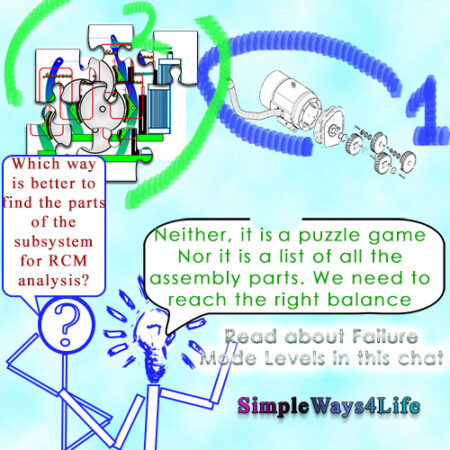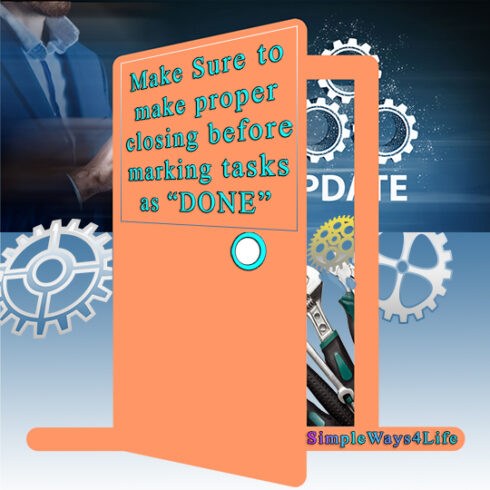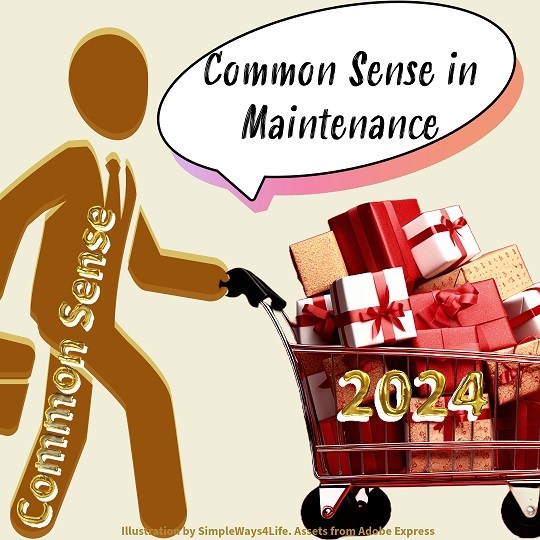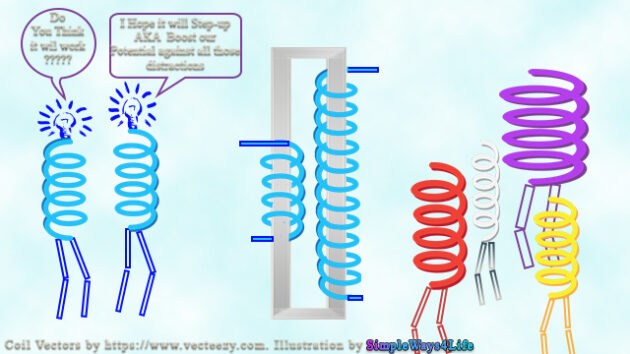This chat includes some practical examples for the Failure Modes of some functions of common equipment. Your prior knowledge of these Failure Modes prepare you before the fact. Even if they didn’t actually happen in your work location, you will be aware of their probability. This discussion will add some eye-opening insights on the failure modes while exploring the failure levels and subsystem partitioning. First we shall see the importance of properly setting up your reliability approach. This proper set up and consciousness of the system parts and failure levels will be the road map to find the right failure modes.
Divide your systems into reasonable subsystems
Above all the advantages of properly splitting the big system into manageable subsystems, comes the focus. Even though we need to include different disciplines within the study group, it would be more beneficial to make a specialized core team for each subsystem. Then comes a one or two supporting members from other disciplines. So, suppose we are studying a cooling water pump skid, you may consider those from mechanical background as the core team. That’s whether they are from the operation or maintenance groups. While, we may include a member from electrical background to cater for the local electrical part onboard the skid.
When we analyze the electrical distribution for the workplace, our focus group will be from electrical disciplines. Then, they need a support from the operation team to reflect the true consequences of the function failures and their modes.
As a result, you will have a meaningful subsystems that enclose closely related parts and are handy for the focus group to analyze. Moreover the size of the analysis result of this subsystem is of manageable size. Lengthy results due to unnecessarily huge subsystems can induce overlooked components or failure modes
Next, Find your subsystem components
Dividing your system into manageable components in its own stimulate the reliability team. Each component of the subsystem, when properly selected, opens the possibilities of finding how it failed previously or how it would fail in the future. Examples would make it clearer:
Electrical disciplines example
When we studied in our previous chat (Failure Modes applications) an electrical local power distribution panel its components were its enclosure, incoming main breaker, distribution breakers, indications and labelling, internal cables or busbars and outgoing cables. Maybe even in that chat we didn’t cover all the possible failures and components that may be found an all panels of that type. But, there are some targets that need to be considered behind this disintegration:
- Each component can have its own failures that affect the function of the subsystem.
- Those failures can preach the safety, operation or environment or can stay dormant as a hidden failure. When another component call for this hiddenly failed function it won’t respond causing a bigger failure.
- There is a repair within hand for this component. Repair means either we can retrieve the function of the same old part. This can be done locally by your team or through a service provider. Or at least can be discarded and a new part will replace it.
How we can see this in the electrical panel failure modes?
- The outgoing cables stimulates the possibility of some failure modes as
- cable terminals get loose due to
- crimping
- weight i.e. absence of support
- vibration or pulling
- the environment through which cable passes makes it subject to:
- high temperature
- water or liquids
- chemically aggressive vapor
- friction between cables or between the cables and their moving rack or wheels
- cable terminals get loose due to
- The panel internal cables or busbars will stimulate the following failure modes
- safety isolation of busbars i.e. preventing unintended access
- failure of cables touching those busbars due to heating -if any-
- The possibility of rodents that might eat the cables or cause short-circuit failure while moving between terminals or bare bars
You can find more examples for failure modes of Electrical substation equipment in this link
Life exampleS
The moral behind these examples is to point out that there is no bullet proof analysis. In other words, listing as much failure modes as possible will leave the least possible chances for surprises. That’s what create a stable operation and a maintenance environment with windows for creativity and improvement.
- The first example was for mice attacking optical cables in the basement of a high voltage substation. The optical cables lack the warmth and aroma that attracts the rodents to electrical cables. Hence, this was never an option and no inspection or spares were ever considered for them.
- Second was for a a chain cable conveyor. Where cleaning underneath the conveyor was done in at a certain retracted position suitable for the load. This led to dust accumulation at one point that sent the conveyor out of track to crash itself while folding and unfolding.
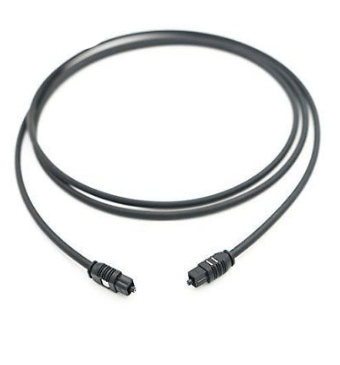
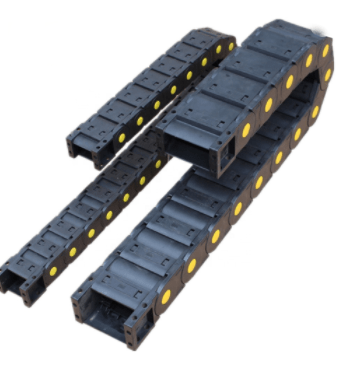
Cooling water pumps and subsystem components
You can assume a single water pump or a pump skid. The subsystem components might be: pump, motor and pipe lines(delivery & suction).
Each of these components has its own parts. Then, those internal parts has its own failure modes that causes failures to the original function e.g delivery of 100 m3/hr of cooling water. If we consider the pump; it has a casing, an impeller, a shaft and some seals. Same for the motor; it has primary and secondary windings, fan, bearings and casing. The pipeline carries the valves whether manual or automatic, the sensors and the filters.
Keep in mind that in the proposed case you have a standby pump, specially if it is a hot standby i.e. ready for auto start. it has a function of “Auto start”. This function has a function failure of “not start on auto request”. When we go through its failure modes of this function failure; Some of those failures are typical to that of a pump that fails while in operation. While other failures are unique to the starting time. Examples of those two failure conditions:
- When standby pump does not start automatically:
- Motor fails
- Electric supply not switched ON
- Motor reversed
- Motor cables not connected
- Pipeline
- Valve left closed
- Pump
- pump not installed after repair
- Motor fails
- When a pump fails while running:
- Motor fails
- Bearing seized
- Insulation fails
- Trip by overload (extra current due to extra torque required by the load)
- Pipeline
- Filter clogged
- Valve failed to closed position
- Valve closed by mistake
- Standby pump valve failed to opened position
- Standby pump valve left open (causing inner circulation)
- Pump
- Seal damaged
- Shaft shears
- Shaft Key shears
- Bearing seized
- Casing ruptured
- Motor fails
Levels of failure modes
Not all the failure modes are at the same level. So, a failure mode might have some root causes (2nd level of failure modes). Moreover those root causes might have deeper causes (3rd level of failure modes) and so on.
We can take one example, follow it through deeper levels to flourish the idea:
- Motor Fails
- Bearing seized
- Lubrication failed
- Grease shortage
- Leaked
- liquified
- heated
- —-
- external heat source
- —-
- —-
- heated
- liquified
- Leaked
- Wrong type used
- Store error
- labelling error
- Wrong supply
- Grease shortage
- Lubrication failed
- Bearing seized
Though the Information collection sheet of the RCM (Reliability-Centered Maintenance) has one column for failure modes, you can make a separate sheet for the failure modes collection session. Then you can summarize the probable one in this one column or extend it to show more than one level. However, this dig down in the root causes of any failure allows you to reach the proper action needed in your situation. This could be totally different from another work location. In another worksite, the bearing might seize because it was wrongly supplied, wrong storage or wrong installation. Do not go to far digging deep behind the root causes because you may reach to causes outside the company’s scope of action.
I believe we had spent enough time with the failure modes and its collection in those three chats. This one will be the last on the failure modes series. The importance of the failure modes stems from the following facts:
- Corrective maintenance treats the consequences of a failure mode
- Preventive or predictive maintenance (Proactive strategies) try to prevent a failure mode.
- The best failure modes to study are those that you had already put in place a maintenance task to prevent or early detect.
In Conclusion,
Todays chat added some eye-opening insights on the failure modes while exploring the failure levels and subsystem partitioning. First step starts at the proper setting up of your reliability approach. This proper set up and consciousness of the system parts and failure levels draw a road map to find the right failure modes.
What a bless coffee is, even in your imagination.

